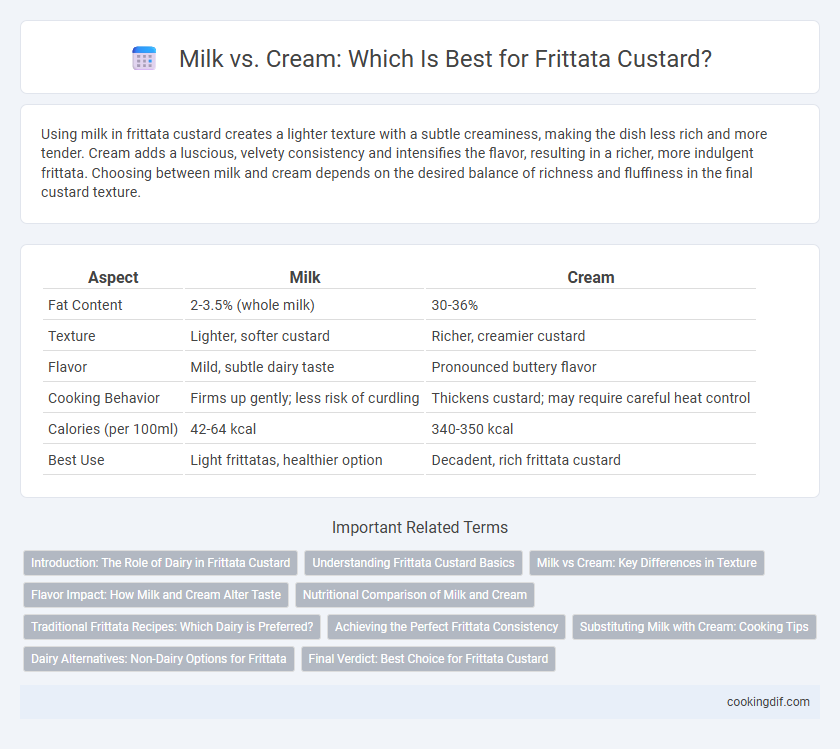Using milk in frittata custard creates a lighter texture with a subtle creaminess, making the dish less rich and more tender. Cream adds a luscious, velvety consistency and intensifies the flavor, resulting in a richer, more indulgent frittata. Choosing between milk and cream depends on the desired balance of richness and fluffiness in the final custard texture.
Table of Comparison
| Aspect | Milk | Cream |
|---|---|---|
| Fat Content | 2-3.5% (whole milk) | 30-36% |
| Texture | Lighter, softer custard | Richer, creamier custard |
| Flavor | Mild, subtle dairy taste | Pronounced buttery flavor |
| Cooking Behavior | Firms up gently; less risk of curdling | Thickens custard; may require careful heat control |
| Calories (per 100ml) | 42-64 kcal | 340-350 kcal |
| Best Use | Light frittatas, healthier option | Decadent, rich frittata custard |
Introduction: The Role of Dairy in Frittata Custard
Milk and cream significantly influence the texture and richness of a frittata custard, with milk offering a lighter, more delicate base and cream providing a denser, more velvety consistency. The fat content in cream enhances flavor depth and creates a custard that holds together more firmly during cooking. Selecting between milk and cream depends on desired richness and the balance of ingredients, directly affecting the mouthfeel and structural integrity of the final frittata.
Understanding Frittata Custard Basics
Frittata custard relies on the right balance of eggs and dairy to achieve a creamy texture without becoming too heavy or dense. Milk provides a lighter, more fluid custard that enhances the frittata's fluffiness, while cream adds richness and a velvety mouthfeel due to its higher fat content. Choosing between milk and cream depends on the desired texture and flavor intensity, with milk yielding a delicate, airy finish and cream producing a richer, more decadent result.
Milk vs Cream: Key Differences in Texture
Milk produces a lighter, more tender frittata custard with a slightly firmer texture, while cream adds richness and a velvety, silky mouthfeel due to its higher fat content. The fat percentage in cream, typically around 30-36%, creates a denser and creamier custard compared to milk's 2-3% fat, influencing the overall fluffiness and moisture retention. Choosing between milk and cream affects the custard's body, with milk yielding a delicate bite and cream offering a luxurious, indulgent finish.
Flavor Impact: How Milk and Cream Alter Taste
Milk provides a lighter, more delicate flavor that allows the natural egg taste to shine through in a frittata custard. Cream introduces a richer, more indulgent texture with a subtle sweetness that enhances the overall depth and mouthfeel. Choosing between milk and cream can significantly impact the taste profile, balancing richness against a cleaner, fresher egg flavor.
Nutritional Comparison of Milk and Cream
Milk provides a lighter frittata custard with fewer calories and less fat, making it a healthier option rich in protein, calcium, and essential vitamins like B12 and D. Cream, on the other hand, delivers a richer texture and higher fat content, significantly increasing calorie density but also contributing to a more indulgent flavor profile. Choosing milk supports lower saturated fat intake, while cream enhances creaminess and satiety due to its emulsified fats.
Traditional Frittata Recipes: Which Dairy is Preferred?
Traditional frittata recipes often favor cream over milk for their custard base due to the richer texture and velvety mouthfeel cream imparts. Using cream increases the fat content, resulting in a custard that is denser and more luxurious, enhancing the egg's natural flavor. Milk, while lighter and more commonly available, produces a custard that is less creamy and may yield a slightly softer frittata texture.
Achieving the Perfect Frittata Consistency
Milk creates a lighter frittata custard with a tender, delicate texture, while cream delivers a richer, creamier consistency due to its higher fat content. Using whole milk balances moisture and structure, resulting in a fluffy yet firm frittata that holds together well. Cream enhances decadence and moisture retention but may yield a denser, custard-like interior, ideal for a more indulgent dish.
Substituting Milk with Cream: Cooking Tips
Substituting milk with cream in frittata custard enhances richness and creaminess, creating a more velvety texture. Use heavy cream sparingly, typically replacing milk at a 1:1 ratio, to avoid an overly dense result while allowing the eggs to set properly. Adjust cooking time slightly; cream-based custards may require a lower heat and longer cooking period to prevent curdling and ensure even doneness.
Dairy Alternatives: Non-Dairy Options for Frittata
Non-dairy alternatives like almond milk, coconut milk, and cashew cream offer creamy textures for frittata custards without dairy. Unsweetened plant-based milks maintain the savory profile while adding subtle nutty or coconut undertones. Silken tofu blended with nutritional yeast provides a rich, custard-like consistency perfect for vegan frittata recipes.
Final Verdict: Best Choice for Frittata Custard
Cream creates a richer and silkier frittata custard due to its higher fat content, enhancing both texture and flavor. Milk offers a lighter, lower-calorie option, resulting in a more delicate and slightly less creamy consistency. For the best balance of creaminess and structure, heavy cream is the optimal choice for a perfectly custardy frittata.
Milk vs Cream for Frittata custard Infographic

 cookingdif.com
cookingdif.com